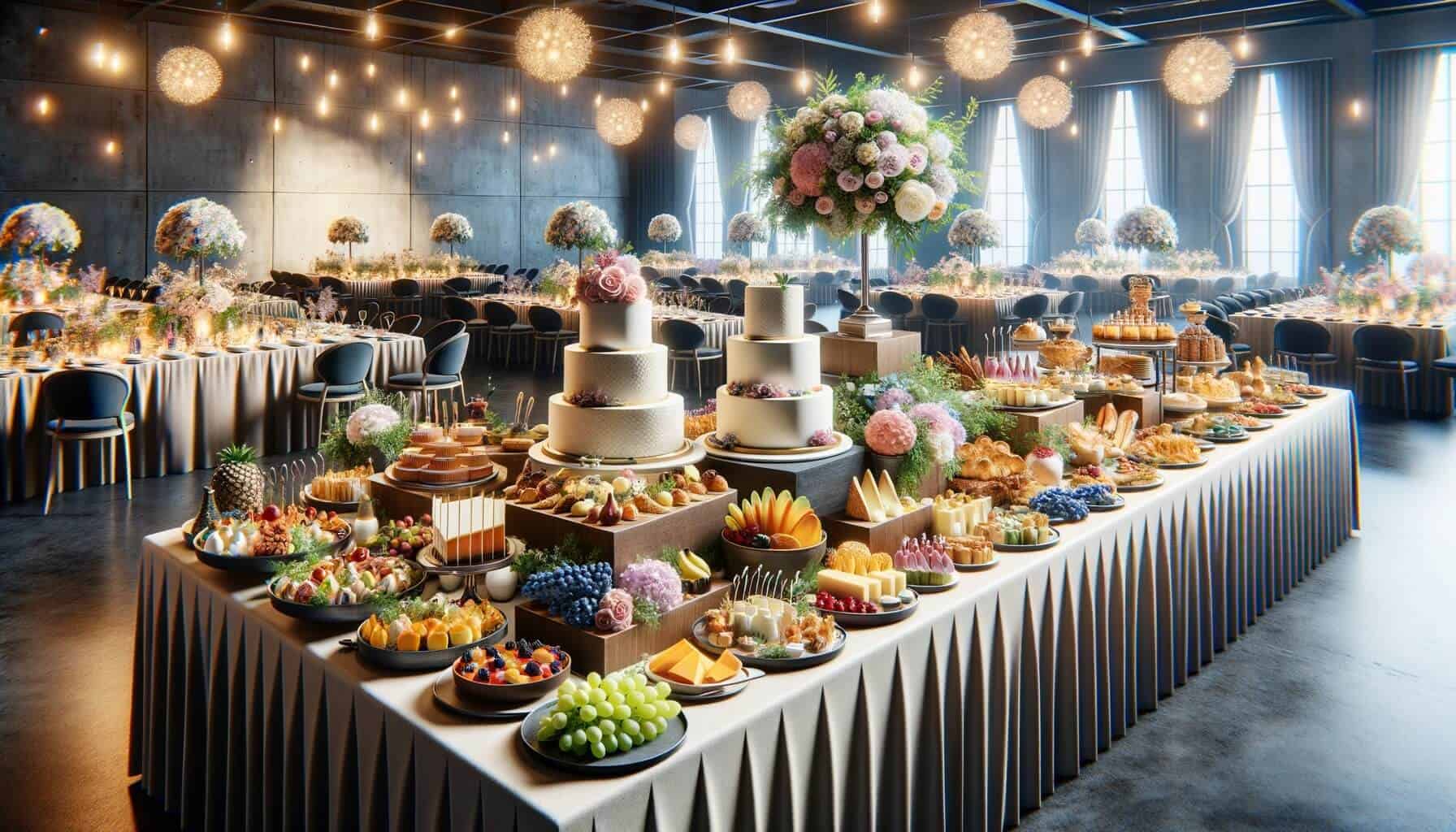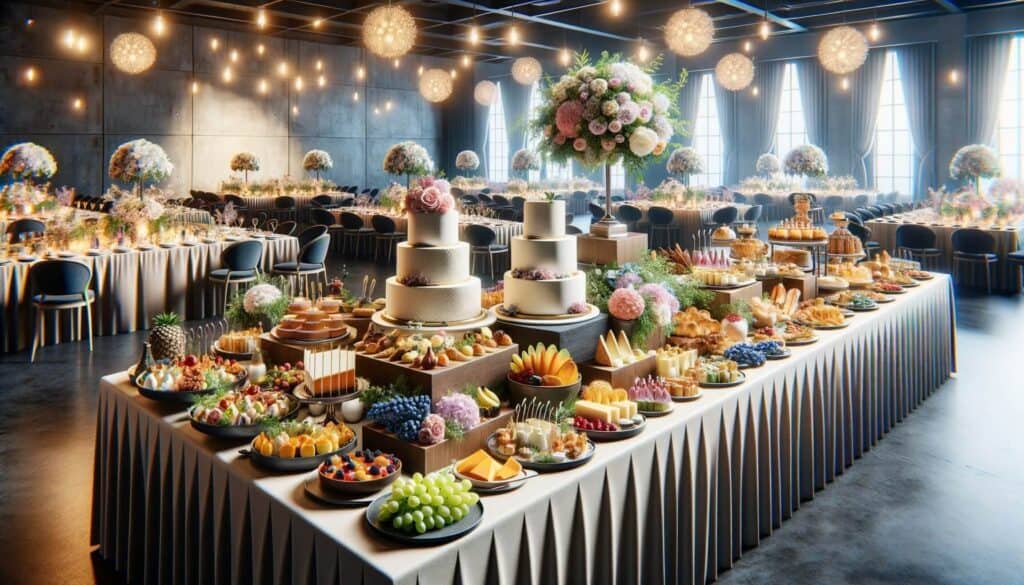
By Jermaine Thomas March 18, 2025
In the competitive world of catering, building a strong portfolio is essential for success. A catering portfolio serves as a visual representation of your skills, expertise, and creativity, showcasing your ability to create memorable events and tantalizing menus. It not only helps you attract potential clients but also establishes your credibility in the industry.
In this article, we will explore the various aspects of building a catering portfolio, including capturing high-quality event photos, highlighting menu ideas, building a catering website, utilizing social media, networking with event planners and vendors, designing a professional catering menu, and incorporating unique elements into events.
Setting the Stage: Capturing High-Quality Event Photos

One of the most crucial elements of a catering portfolio is high-quality event photos. These photos serve as a visual narrative of your work, allowing potential clients to envision the type of events you can create. When capturing event photos, it is important to pay attention to details such as lighting, composition, and presentation.
Hiring a professional photographer who specializes in event photography can greatly enhance the quality of your portfolio. Additionally, make sure to capture a variety of shots, including close-ups of food, candid moments, and overall event ambiance.
To ensure that your event photos are of the highest quality, consider the following tips:
1. Plan ahead: Discuss the event details with the photographer in advance to ensure they understand your vision and the key moments you want to capture.
2. Lighting is key: Choose venues with ample natural light or invest in professional lighting equipment to create a visually appealing atmosphere.
3. Pay attention to composition: Frame your shots carefully, considering the placement of food, decor, and people to create visually pleasing images.
4. Capture the details: Don’t forget to photograph the small details that make your events unique, such as table settings, floral arrangements, and custom signage.
5. Edit and curate: After the event, carefully select the best photos and edit them to enhance their visual appeal. Avoid over-editing, as it can make the images look unnatural.
By investing time and effort into capturing high-quality event photos, you can create a visually stunning portfolio that will impress potential clients and set you apart from the competition.
Showcasing Your Culinary Expertise: Highlighting Menu Ideas

A catering portfolio is incomplete without showcasing your culinary expertise. Your menu ideas should reflect your creativity, versatility, and ability to cater to different tastes and dietary preferences. When selecting menu items to include in your portfolio, consider the following factors:
1. Variety: Include a diverse range of menu ideas that cater to different types of events, such as weddings, corporate functions, and social gatherings. This will demonstrate your ability to adapt to various settings and client preferences.
2. Seasonality: Incorporate seasonal ingredients and flavors into your menu ideas to showcase your ability to create fresh and innovative dishes.
3. Dietary restrictions: Highlight menu options for clients with dietary restrictions, such as vegetarian, vegan, gluten-free, or dairy-free options. This will demonstrate your ability to accommodate diverse dietary needs.
4. Presentation: Pay attention to the visual presentation of your dishes. Include photos that showcase the artistry and attention to detail in your plating and garnishing techniques.
5. Signature dishes: Highlight any signature dishes or unique culinary creations that set you apart from other caterers. These dishes can become your trademark and help you build a distinct brand identity.
Crafting an Impressive Online Presence: Building a Catering Website

In today’s digital age, having a strong online presence is crucial for any business, including catering. A well-designed catering website serves as a virtual storefront, allowing potential clients to learn more about your services, view your portfolio, and contact you for inquiries. When building a catering website, consider the following tips:
1. Professional design: Invest in a professional website design that reflects your brand identity and creates a visually appealing user experience. Use high-quality images, clear typography, and intuitive navigation to engage visitors.
2. Mobile-friendly: Ensure that your website is optimized for mobile devices, as an increasing number of people use smartphones and tablets to browse the internet. A mobile-friendly website will improve user experience and increase your chances of attracting potential clients.
3. Clear and concise information: Provide clear and concise information about your catering services, including your areas of expertise, pricing, and contact details. Avoid overwhelming visitors with excessive text or unnecessary information.
4. Showcase your portfolio: Create a dedicated section on your website to showcase your portfolio. Include high-quality images of events you have catered, along with brief descriptions highlighting your unique approach and the success of each event.
5. Testimonials and reviews: Incorporate testimonials and reviews from satisfied clients on your website. Positive feedback from previous clients can greatly enhance your credibility and attract new clients.
Utilizing Social Media: Promoting Your Catering Portfolio

In addition to a professional website, social media platforms provide an excellent opportunity to promote your catering portfolio and engage with potential clients. Social media allows you to reach a wider audience, showcase your work in real-time, and build a community of followers who are interested in your services. When utilizing social media for promoting your catering portfolio, consider the following tips:
1. Choose the right platforms: Identify the social media platforms that are most relevant to your target audience. For example, Instagram is a visual platform that is ideal for showcasing event photos, while LinkedIn is more suited for networking with event planners and vendors.
2. Consistent branding: Maintain consistent branding across all your social media profiles. Use the same logo, color scheme, and tone of voice to create a cohesive brand identity.
3. Engage with your audience: Respond to comments, messages, and inquiries in a timely manner. Engage with your followers by posting behind-the-scenes content, sharing industry insights, and responding to trends and current events.
4. Hashtags and keywords: Use relevant hashtags and keywords in your social media posts to increase visibility and reach a wider audience. Research popular catering-related hashtags and incorporate them into your posts.
5. Collaborate with influencers: Partner with influencers or industry experts who have a significant following on social media. Collaborating with influencers can help you reach a larger audience and gain credibility in the industry.
Networking and Collaborating: Partnering with Event Planners and Vendors
Networking and collaborating with event planners and vendors is a valuable strategy for building a strong catering portfolio. By establishing relationships with professionals in the event industry, you can gain access to new opportunities, expand your network, and enhance your reputation. When networking and collaborating with event planners and vendors, consider the following tips:
1. Attend industry events: Participate in industry conferences, trade shows, and networking events to meet event planners and vendors. These events provide an opportunity to showcase your portfolio, exchange ideas, and build relationships.
2. Offer tastings and demonstrations: Invite event planners and vendors to tastings and demonstrations where they can experience your culinary creations firsthand. This allows them to assess the quality of your food and presentation, increasing the likelihood of referrals and collaborations.
3. Establish partnerships: Collaborate with event planners and vendors to offer comprehensive event packages. By partnering with professionals in related fields, such as florists, photographers, or event coordinators, you can provide clients with a seamless and memorable event experience.
4. Cross-promotion: Cross-promote your services with event planners and vendors by featuring each other’s work on your respective websites and social media platforms. This mutually beneficial arrangement can help you reach a wider audience and attract new clients.
5. Maintain professional relationships: Nurture your professional relationships by staying in touch with event planners and vendors. Send occasional updates about your latest projects, offer exclusive discounts, or simply express your gratitude for their support. Building strong relationships can lead to long-term collaborations and referrals.
Creating a Stellar Presentation: Designing a Professional Catering Menu
A professional catering menu is an essential component of your portfolio, as it showcases your ability to create a cohesive and visually appealing dining experience. When designing a catering menu, consider the following tips:
1. Clear and concise format: Present your menu in a clear and concise format that is easy to read and understand. Use headings, subheadings, and bullet points to organize the information and make it visually appealing.
2. Descriptive language: Use descriptive language to entice readers and create a sensory experience. Describe the flavors, textures, and aromas of each dish to make the menu come alive.
3. Visual elements: Incorporate visual elements such as high-quality food photos, illustrations, or graphics to enhance the visual appeal of your menu. Visual representations of your dishes can help clients visualize the dining experience you offer.
4. Customization options: Provide customization options for clients to tailor the menu to their preferences. This can include options for different courses, dietary restrictions, or themed menus.
5. Pricing transparency: Clearly indicate the pricing for each menu item or package to avoid any confusion or surprises for clients. Transparency in pricing builds trust and helps clients make informed decisions.
Showcasing Your Signature Style: Incorporating Unique Elements into Events
To stand out in the catering industry, it is important to incorporate unique elements into your events that reflect your signature style. These unique elements can range from creative food presentations to innovative event concepts. When incorporating unique elements into events, consider the following tips:
1. Creative food presentations: Experiment with different food presentation techniques to create visually stunning dishes. This can include techniques such as molecular gastronomy, edible flowers, or interactive food stations.
2. Customized menus: Offer customized menus that reflect the client’s preferences, cultural background, or theme of the event. This personalization adds a unique touch to the event and creates a memorable experience for guests.
3. Interactive experiences: Incorporate interactive elements into your events to engage guests and create a sense of excitement. This can include live cooking stations, DIY food bars, or chef demonstrations.
4. Themed events: Create themed events that transport guests to a different time, place, or concept. This can include themed decorations, costumes, and menu items that align with the chosen theme.
5. Collaboration with artists: Partner with local artists, musicians, or performers to add an artistic element to your events. This collaboration can create a multi-sensory experience for guests and elevate the overall ambiance of the event.
Frequently Asked Questions (FAQs) about Building a Catering Portfolio
Q1. How many events should I include in my catering portfolio?
A: It is recommended to include a variety of events in your portfolio, showcasing your ability to cater to different types of occasions. Aim to include at least 10-15 events that highlight your versatility and expertise.
Q2. Should I hire a professional photographer for my event photos?
A: Hiring a professional photographer can greatly enhance the quality of your event photos. They have the expertise and equipment to capture the best moments and create visually stunning images. However, if hiring a professional is not feasible, make sure to invest time in learning basic photography techniques and use high-quality equipment.
Q3. How often should I update my catering portfolio?
A: It is important to regularly update your catering portfolio to showcase your latest work and keep it relevant. Aim to update your portfolio at least once every six months or whenever you have significant new events or menu ideas to showcase.
Q4. How can I attract clients through social media?
A: To attract clients through social media, focus on creating visually appealing content, engaging with your audience, and showcasing your expertise. Use high-quality images, post regularly, respond to comments and inquiries, and collaborate with influencers or industry experts to increase your visibility and credibility.
Q5. How can I differentiate my catering menu from competitors?
A: To differentiate your catering menu from competitors, focus on offering unique dishes, incorporating seasonal ingredients, and providing customization options. Additionally, pay attention to the visual presentation of your dishes and use descriptive language to create a sensory experience for clients.
Conclusion
Building a catering portfolio is a crucial step towards establishing a successful catering business. By showcasing high-quality event photos, highlighting menu ideas, building a professional catering website, utilizing social media, networking with event planners and vendors, designing a professional catering menu, and incorporating unique elements into events, you can create a comprehensive and impressive portfolio that attracts potential clients and sets you apart from the competition.
Remember to regularly update your portfolio, stay current with industry trends, and continuously strive to improve your skills and offerings. With a strong portfolio, you can confidently showcase your expertise and creativity, ultimately leading to increased business opportunities and success in the catering industry.